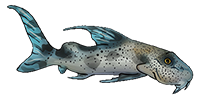| Scientific Name | Ageneiosus uranophthalmus Ribeiro & Rapp Py-Daniel, 2010 |
| Common Name | |
| Type Locality | Rio Amazonas below Paraná da Eva, ca. 3°13'S, 59°01'W, Itacoatiara, Amazonas State, Brazil. |
| Pronunciation | ah genie OH sus |
| Etymology | Ageneiosus, from the Greek a, meaning without and genias, meaning beard in reference to the apparent lack of barbels. In fact, catfish of this genus have very short maxillary barbels that are almost indistinguishable to the human eye. |
| Size | 230mm or 9.1" SL. Find near, nearer or same sized spp. |
| Identification | Ageneiosus differs from other Auchenipteridae, except Tympanopleura, by having: 1, long bony process, narrowing distally on anterolateral border of sphenoid; 2, longitudinal groove on posterior margin of anterior fontanel (also present in Pseudepapterus); 3, dorsal portion of posttemporal-supracleithrum divided into two prominent branches; 4, internal and external processes of epioccipital sutured to parapophyses of fifth and sixth vertebrae; 5, bony process on posteromedial border of first infraorbital bone (also present in Tetranematichthys); 6, anterior or posterior region of second infra-orbital very curved; 7, bony expansion on laterodorsal margin of premaxilla; 8, operculum with spongy ossification; 9, bone projections on posterior extreme of the parurohyal; 10, seventh vertebra not fused to complex vertebrae (also present in Pseudepapterus); 11, well-developed crown of spines in proximal region of anterior margin of dorsal-fin spine of mature males; 12, short maxillary barbel, not extending posteriorly beyond snout (also present in Tetranematichthys); 13, mental barbels absent; 14, bony spines on maxillary barbel of mature males; 15, posterior lobes of testes reduced or absent (also present in Auchenipterus). Ageneiosus differs from Tympanopleura by having: 1, reduced and completely ossified gas bladder in adults, except Ageneiosus pardalis Lütken 1874 (v. large, non-ossified gas bladder during all phases of ontogenetic development); 2, posterior diverticula on the gas bladder absent (v. having paired posterior diverticula on the gas bladder, except T. piperata); 3, epaxial muscles almost completely covering the tympanic region in adults, except A. pardalis (v. tympanic region translucent, not covered by epaxial muscles); 4, dorsal process on the base of pectoral fin weakly developed, loosely articulating with cleithrum (v. dorsal process on the base of pectoral fin well developed, strongly articulating with cleithrum); 5, fenestra on the lateral wall of cleithrum (v. lateral wall of cleithrum completely ossified). A key to the species of Ageneiosus is located here. |
| Sexing | Observed in nuptial males. Predorsal profile distinctly more acutely angled upward than in females, juveniles and non-nuptial males. Maxillary barbel entirely ossified, forming a rigid, thickened, elongate barbel that may reach beyond the anterior eye margin when adpressed to the side of the head. Two rows of sharp recurved hooks on dorsal margin of barbel. Articular surface of maxilla expanded for contact with autopalatine. Dorsal-fin spine elongate, rigid, aculeiform, straight to strongly arched. Anterior margin of the dorsal-fin spine with pungent, unicuspid serrae, closely spaced proximally, recurved laterally, forming an enlarged, ossified protuberance at the anterior base of the spine; serrae distally arranged in a row, sometimes absent along middle quarter to third of spine. Dorsal-fin spine of nuptial males may be hyperextended anteriorly to approximately a 45° dorso-anterior angle, instead of the near-vertical limit of females and juveniles. The first branched dorsal-fin ray is much longer than in non-breeding males and females. Unbranched and first few branched anal-fin rays thickened and elongate to form a tubular intromittent organ bound by integument to the anterior margin of the anal fin. Urogenital opening of nuptial male displaced as a simple pore at the distal tip of intromittent organ. |
| Distribution | Middle reaches of Amazon River Basin, Brazil. Amazon, Middle Amazon (Solimoes) (click on these areas to find other species found there) Login to view the map. |
| IUCN Red List Category | Least Concern , range map and more is available on the IUCN species page. Last assessed 2018. |
| Breeding | Unreported. |
| Breeding Reports | There is no breeding report. |
| Reference | Neotropical Ichthyology v. 8 (no. 1), pp 98, Figs. 1-2. |
| Registered Keepers | There is no registered keeper. |
| Wishlists | Love this species? Click the heart to add it to your wish list. There is no wish to keep this species. |
| Spotters | Spotted this species somewhere? Click the binoculars! There is no record of this fish being seen. |
| Forum BBCode | |
| Search for A. uranophthalmus | |
| Look up A. uranophthalmus on AquaticRepublic.com | |
 | Look up A. uranophthalmus on Fishbase |
 | Look up A. uranophthalmus on Encyclopedia of Life |
 | Look up A. uranophthalmus on Global Biodiversity Information Facility |
| LFS label creator ARN ref:1.22.105.1127 | |
| Last Update | 2025 Jan 02 01:36 (species record created: 2003 Oct 08 00:00) |





/siluriformes/auchenipteridae/ageneiosus/uranophthalmus/1.jpg)
/siluriformes/auchenipteridae/ageneiosus/uranophthalmus/2.jpg)
/siluriformes/auchenipteridae/ageneiosus/uranophthalmus/3.jpg)
/siluriformes/auchenipteridae/ageneiosus/uranophthalmus/4.jpg)